English translation of the book:Pierre Jurieu. L'accomplissement des Propheties ou la delivrance prochaine de l'Eglise. —Rotterdam: Acher, 1686.
-
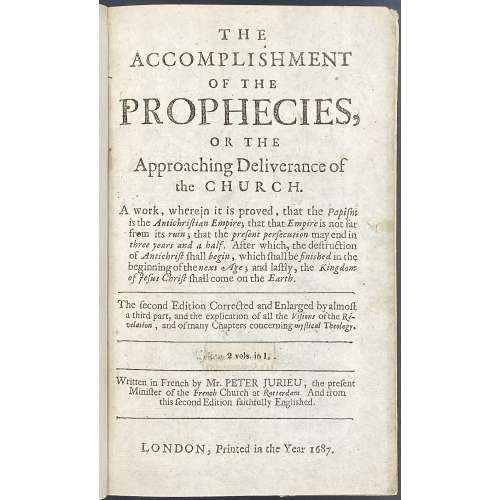 Title page (with tall “s”): THE | ACCOMPLISHMENT | OF THE | PROPHECIES, | OR THE | Approaching Deliverance of | the CHURCH. | A work, wherein it is proved, that the Papism | is the Antichristian Empire; that that Empire is not far | from its ruin ; that the present persecution may end in | three years and a half. After which, the destruction | of Antichrist shall begin, which shall be finished in the | beginning of the next Age ; and lastly, the Kingdom | of Jesus Christ shall come on the Earth. | — | The second Edition Corrected and Enlarged by almost | a third part, and the explication of all the Visions of the Re- | velation, and of many Chapters concerning mystical Theology. | — | 2 vols. In 1, | — | Written in French by Mr. PETER JURIEU , the present | Minister of the French Church at Rotterdam. And from | this second Edition faithfully Englished. | — | LONDON , Printed in the Year 1687. || Pagination: ffl, [48] 1-271 [272 blank] + 3-99, 200-396, bfl. Note: part 2 starts with page 3, page 99 recto is paginated 200 on verso, instead of 100; total number of pages in part 2, thus, is 294. Collation is uninterrupted. Collation: *-**8 A-S8 + Aa7 Bb-Ss8 Tt4. Note: no leaf Aa1, leaf Tt4 unsigned; 307 leaves total. Binding: Full brown calf, boards ruled blind with double-fillet, flat spine stamped blind with a diaper, double-fillet ruled compartments, black label with gilt lettering. Printed on laid paper, with marginal notes. Yellow sticker to front pastedown G. Batenham, Bookseller, Northgate, Chester. Author: Pierre Jurieu (French, 1637 – 1713). Translator unknown. Publisher unknown.
Title page (with tall “s”): THE | ACCOMPLISHMENT | OF THE | PROPHECIES, | OR THE | Approaching Deliverance of | the CHURCH. | A work, wherein it is proved, that the Papism | is the Antichristian Empire; that that Empire is not far | from its ruin ; that the present persecution may end in | three years and a half. After which, the destruction | of Antichrist shall begin, which shall be finished in the | beginning of the next Age ; and lastly, the Kingdom | of Jesus Christ shall come on the Earth. | — | The second Edition Corrected and Enlarged by almost | a third part, and the explication of all the Visions of the Re- | velation, and of many Chapters concerning mystical Theology. | — | 2 vols. In 1, | — | Written in French by Mr. PETER JURIEU , the present | Minister of the French Church at Rotterdam. And from | this second Edition faithfully Englished. | — | LONDON , Printed in the Year 1687. || Pagination: ffl, [48] 1-271 [272 blank] + 3-99, 200-396, bfl. Note: part 2 starts with page 3, page 99 recto is paginated 200 on verso, instead of 100; total number of pages in part 2, thus, is 294. Collation is uninterrupted. Collation: *-**8 A-S8 + Aa7 Bb-Ss8 Tt4. Note: no leaf Aa1, leaf Tt4 unsigned; 307 leaves total. Binding: Full brown calf, boards ruled blind with double-fillet, flat spine stamped blind with a diaper, double-fillet ruled compartments, black label with gilt lettering. Printed on laid paper, with marginal notes. Yellow sticker to front pastedown G. Batenham, Bookseller, Northgate, Chester. Author: Pierre Jurieu (French, 1637 – 1713). Translator unknown. Publisher unknown. -
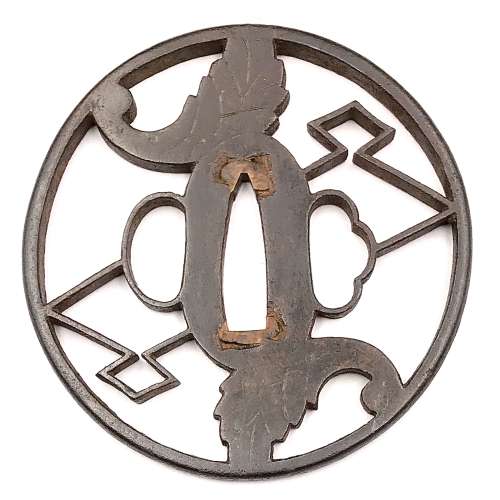 Iron tsuba of round form with design of ginger and double diamonds (myoga-ni-nigaibishi) in openwork (sukashi), details carved in kebori technique. Slightly rounded square rim. Copper sekigane. Shoami school. Early Edo period: Late 17th century (Kanbun/Enppo era). Height: 80.1 mm. Width: 79.8 mm. Rim thickness: 5.0 mm. Center thickness: 4.7 mm. Provenance: Sasano Masayuki Collection, № 110.
Iron tsuba of round form with design of ginger and double diamonds (myoga-ni-nigaibishi) in openwork (sukashi), details carved in kebori technique. Slightly rounded square rim. Copper sekigane. Shoami school. Early Edo period: Late 17th century (Kanbun/Enppo era). Height: 80.1 mm. Width: 79.8 mm. Rim thickness: 5.0 mm. Center thickness: 4.7 mm. Provenance: Sasano Masayuki Collection, № 110. -

Small iron tsuba (tantō size) of oval form carved with imitation of six overlapping plates, decorated with paulownia blossoms, leaves, and tendrils in brass and copper hira-zōgan. Copper sekigane. Open kozuka hitsu-ana.
Early Edo period, 17th century.
Size: 50.5 x 34.0 x 4.9 mm.
-
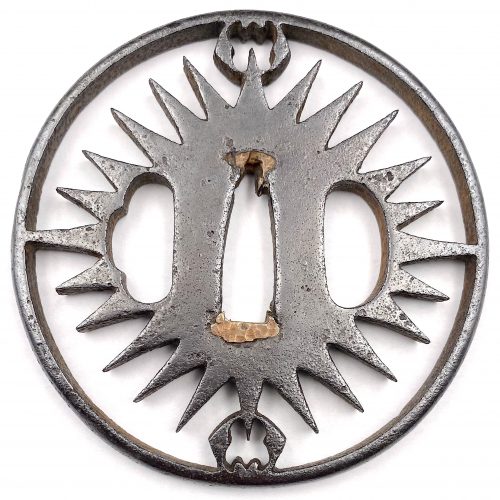 Iron tsuba of the round form (maru gata) with a grey patina pierced with the design of slanting rays of light (Jesuit’s IHS symbol) and a pair of ginger symbols [茗荷] (myōga) at top and bottom, in positive silhouette (ji-sukashi). This design is often called “tokei” [時計] or “clock gear”. Rounded rim, large hitsu-ana, copper fittings (sekigane). Unsigned, unpapered. Owari school. Early Edo period, early 17th century.
Iron tsuba of the round form (maru gata) with a grey patina pierced with the design of slanting rays of light (Jesuit’s IHS symbol) and a pair of ginger symbols [茗荷] (myōga) at top and bottom, in positive silhouette (ji-sukashi). This design is often called “tokei” [時計] or “clock gear”. Rounded rim, large hitsu-ana, copper fittings (sekigane). Unsigned, unpapered. Owari school. Early Edo period, early 17th century.Size: H 71.9 x W 71.1 x Th (centre) 5.5 cm.
For information regarding this type of tsuba see the article 'Kirishitan Ikenie Tsuba by Fred Geyer at Kokusai Tosogu Kai; The 2nd International Convention & Exhibition, October 18-23, 2006, pp. 84-91. 
IHS emblem of the Jesuits

茗荷 Myoga or Japanese ginger
-
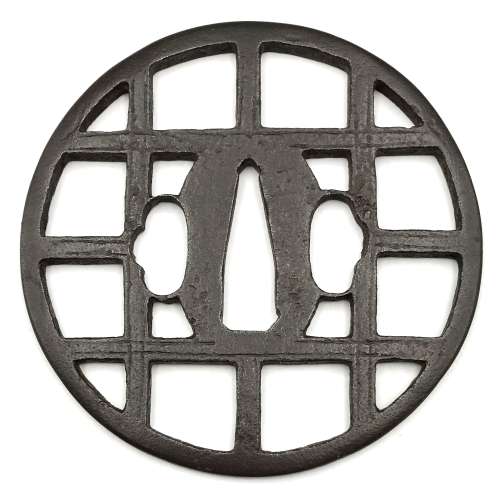 Iron tsuba of round form with design of lattice (kōshi-mon, 格子文) cut in openwork (sukashi), with low relief shallow linear carving along the bars. Well forged plate with brown-ish hue. To the right of nakago-ana there is a clear inscription of the character Shō (正), which is explained by Markus Sesko is follows: "The Shinsa obviously recognized more from the signature when having the tsuba in hand, i.e. they were confident to say it is signed "Shōami" but the rest is illegible (ika-fumei, 以下不明). That is, if they were just able to read the first character SHŌ (正) and saw that there were two more, most likely A (阿) and MI (弥), they would have put those character in boxes on the paper. Boxes around characters namely means that the character is not 100% legible but it can be assumed what it is." Momoyama or early Edo period. Dimensions: 85.9 mm diameter, 3.6 mm thickness at seppa-dai. Weight: 79 g. NBTHK certificate № 425069 with attestation: Hozon - "Worthy of preservation". A similar tsuba is presented at Japanese Sword Fittings from the R. B. Caldwell Collection. Sale LN4188 "HIGO". Sotheby's, 30th March 1994, №15. The description says: "A rare early Kamakura-bori tsuba. Nambokucho period (late 14th century). Of circular form, the dark plate carved and pierced with a gate design, the struts with double engraved lines. Unsigned. 8.5 cm." The lot was sold for 1,840 GBP.We have two possible explanations of the discrepancy between Sotheby's and Shinsa/Sesko attribution: 1) either Sotheby's or Shinsa/Sesko were wrong in their attribution or 2) these are two different pieces, one - Kamakura-bori from the 14th century and another - Shōami from 16th/17th century. Anyway, I would consider my piece as a Shōami tsuba of Momoyama - early Edo period, just for the sake of modesty.
Iron tsuba of round form with design of lattice (kōshi-mon, 格子文) cut in openwork (sukashi), with low relief shallow linear carving along the bars. Well forged plate with brown-ish hue. To the right of nakago-ana there is a clear inscription of the character Shō (正), which is explained by Markus Sesko is follows: "The Shinsa obviously recognized more from the signature when having the tsuba in hand, i.e. they were confident to say it is signed "Shōami" but the rest is illegible (ika-fumei, 以下不明). That is, if they were just able to read the first character SHŌ (正) and saw that there were two more, most likely A (阿) and MI (弥), they would have put those character in boxes on the paper. Boxes around characters namely means that the character is not 100% legible but it can be assumed what it is." Momoyama or early Edo period. Dimensions: 85.9 mm diameter, 3.6 mm thickness at seppa-dai. Weight: 79 g. NBTHK certificate № 425069 with attestation: Hozon - "Worthy of preservation". A similar tsuba is presented at Japanese Sword Fittings from the R. B. Caldwell Collection. Sale LN4188 "HIGO". Sotheby's, 30th March 1994, №15. The description says: "A rare early Kamakura-bori tsuba. Nambokucho period (late 14th century). Of circular form, the dark plate carved and pierced with a gate design, the struts with double engraved lines. Unsigned. 8.5 cm." The lot was sold for 1,840 GBP.We have two possible explanations of the discrepancy between Sotheby's and Shinsa/Sesko attribution: 1) either Sotheby's or Shinsa/Sesko were wrong in their attribution or 2) these are two different pieces, one - Kamakura-bori from the 14th century and another - Shōami from 16th/17th century. Anyway, I would consider my piece as a Shōami tsuba of Momoyama - early Edo period, just for the sake of modesty.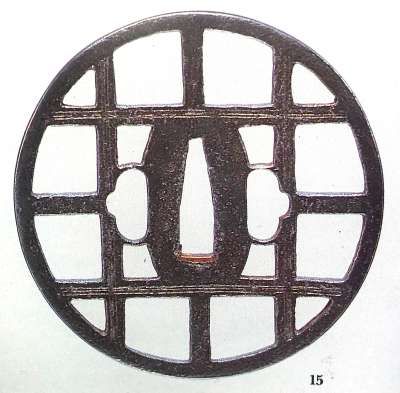
Caldwell Collection. Sotheby's 1994, №15.
-
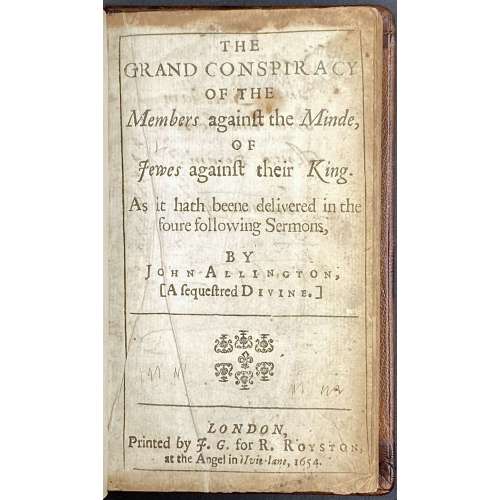 Title: THE | GRAND CONSPIRACY | OF THE | Members again∫t the Minde, | OF | Jewes again∫t their King. | As it hath beene delivered in the | foure following Sermons, | BY | John Allington, [A ∫eque∫tered Divine.] | — | {ornament} | — | LONDON, | Printed by J.G. for R. Royston, | at the Angel in Ivie-lane, 1654.|| Contents: Grand conspiracy of Jewes against their King. A sermon preached in August 1647; Grand conspiracy of Jewes against their King. A sermon preached in January 1649; Grand conspiracy of Jewes against their King. A demonstration of the highest insolencies proceed from men of the lowest and most base extractions Pagination: [2] – t.p. / blank; 1-214. Collation: 12mo; A-I12. Binding: Hardcover; 15 x 9.5 cm, later blind-stamped morocco, raised bands, gilt lettering in compartments. Inscription: Ink by hand by John Bartham, January 30, 1665, to t.p. verso; Pencil by hand to front pastedown: Wing A 1209A.
Title: THE | GRAND CONSPIRACY | OF THE | Members again∫t the Minde, | OF | Jewes again∫t their King. | As it hath beene delivered in the | foure following Sermons, | BY | John Allington, [A ∫eque∫tered Divine.] | — | {ornament} | — | LONDON, | Printed by J.G. for R. Royston, | at the Angel in Ivie-lane, 1654.|| Contents: Grand conspiracy of Jewes against their King. A sermon preached in August 1647; Grand conspiracy of Jewes against their King. A sermon preached in January 1649; Grand conspiracy of Jewes against their King. A demonstration of the highest insolencies proceed from men of the lowest and most base extractions Pagination: [2] – t.p. / blank; 1-214. Collation: 12mo; A-I12. Binding: Hardcover; 15 x 9.5 cm, later blind-stamped morocco, raised bands, gilt lettering in compartments. Inscription: Ink by hand by John Bartham, January 30, 1665, to t.p. verso; Pencil by hand to front pastedown: Wing A 1209A.


